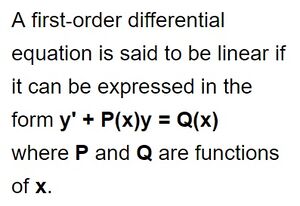Linear differential equation (nonfiction)
In mathematics, a linear differential equation is a differential equation that is defined by a linear polynomial in the unknown function and its derivatives.
A first‐order differential equation is said to be linear if it can be expressed in the form:
y' + P(x)y = Q(x)
where P and Q are functions of x. The method for solving such equations is similar to the one used to solve nonexact equations. There, the nonexact equation was multiplied by an integrating factor, which then made it easy to solve (because the equation became exact).
This is an ordinary differential equation (ODE). A linear differential equation may also be a linear partial differential equation (PDE), if the unknown function depends on several variables, and the derivatives that appear in the equation are partial derivatives. In this article, only ordinary differential equations are considered.
A linear differential equation or a system of linear equations such that the associated homogeneous equations have constant coefficients may be solved by quadrature (mathematics), which means that the solutions may be expressed in terms of integrals. This is also true for a linear equation of order one, with non-constant coefficients. An equation of order two or higher with non-constant coefficients cannot, in general, be solved by quadrature. For order two, Kovacic's algorithm allows deciding whether there are solutions in terms of integrals, and computing them if any.
The solutions of linear differential equations with polynomial coefficients are called holonomic functions. This class of functions is stable under sums, products, derivation, integration, and contains many usual functions and special functions such as exponential function, logarithm, sine, cosine, inverse trigonometric functions, error function, Bessel functions and hypergeometric functions. Their representation by the defining differential equation and initial conditions allows making algorithmic (on these functions) most operations of calculus, such as computation of antiderivatives, limits, asymptotic expansion, and numerical evaluation to any precision, with a certified error bound.
In the News
Fiction cross-reference
Nonfiction cross-reference
- Equation (nonfiction)
- Function (nonfiction)
- Differential equation (nonfiction)
- Mathematics (nonfiction)
- Physics (nonfiction)
External links:
- Linear differential equation @ Wikipedia
- First-order linear equations @ CliffsNotes

